 .
.Michael Fowler
University of Virginia
Physics 252 Home Page
Link to Previous Lecture
We learned from solving Schrödinger's equation for a particle in a one-dimensional box that there is a set of solutions, the stationary states, for which the time dependence is just an overall rotating phase factor, and these solutions correspond to definite values of the energy. An alternative way of finding that set of solutions is separation of variables. The basic strategy is to assume that the solution to the wave equation can be factored into a product of two functions, one depending only on time, the other on the spatial variable,
 .
.If this solution is substituted in the Schrödinger equation, and the result divided by psi(x,t), we find

On writing the equation in this form, it is clear that the left
hand side is only a function of t, not of x,
and the right hand side is only a function of x!
This can only make sense if in fact both sides are the
same constant. If we denote this constant by E, we
can write two equations:
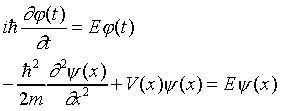
The solution to the first equation just gives the phase time dependence,

and the second is the time independent Schrödinger equation as before. The solutions to this equation are determined by the boundary conditions on psi, in general there is a sequence of such eigenstates labeled by a quantum number n = 0,1,2,3,…, with corresponding values E0, E1, …, which are put in the corresponding phi.
Let us now consider the Schrödinger equation for an electron confined to a two dimensional box, 0 < x < a, 0 < y < b. That is to say, within this rectangle the electron wave function behaves as a free particle (V(x,y) = 0), but the walls are impenetrable so the wave function psi(x,y,t) = 0 at the walls. What do we expect the wave function to look like?
First notice that the separation of variables trick given above for one dimension works equally well here, writing

gives
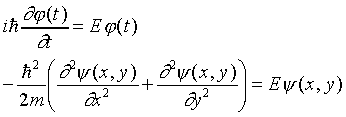
The surprising thing at this point is that we can do the separation of variables trick again -- we can write

and substitute in the above equation to find
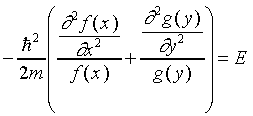
Again, we have an equation in which only one term is x-dependent,
so it must be a constant (which we take to be negative for future
convenience),
 .
.
This is exactly the same equation we dealt with in the one dimensional
case, so we know

with n an integer, and the constant C is equal to
n2pi2/a2.
Hence the energy levels in this rectangular well are given by

with n,m the two quantum numbers needed to label each state.
Two distinct wave functions are said to be degenerate if
they correspond to the same energy. If the sides a,
b of the rectangle are such that a/b is irrational
(the general case), there will be no degeneracies. The most degenerate
case is the square, a = b, for which clearly Em,n
= En,m. Degeneracies in quantum physics are
most often associated with symmetries in this way.
We give here examples of wave functions (3,2) and (2,3) for a rectangle. These are contour maps for the time-independent solution, with white being the highest point, black the lowest. These two wave functions do not correspond to the same energy, although they would, of course, for a square, where one would be the other viewed turned through ninety degrees.
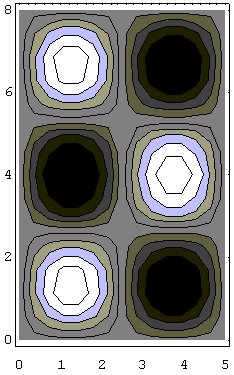
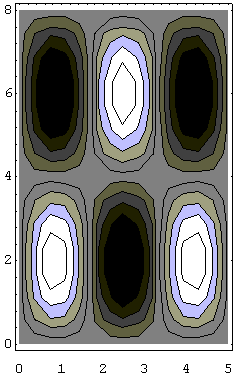
There is a well-known (scanning tunneling microscope) picture
of a "corral" of 48 iron atoms arranged in a circle
on a flat surface. The picture suggests that there are local electron
states in the corral, there are concentric rings of electron density
inside (but not outside) the atomic ring.
Let us assume the situation is well described by V(r)
= 0 for r < a, V(r) infinite for
r > a. It is convenient to write the time independent
Schrödinger equation in the form
 .
.Since the system we are analyzing has circular symmetry, it is natural to try for a solution by separating variables

Expressing del2 in (r, theta )
coordinates, Schrödinger's equation in zero potential becomes:

Substituting the factored wave function  in this equation, and dividing by psi as before, gives
the two equations:
in this equation, and dividing by psi as before, gives
the two equations:
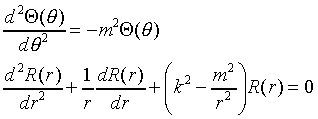
The constant term that arises when a function of r is equal
to a function of theta we set equal to m2,
for reasons that are immediately apparent on examining the
theta equation above. The solutions to this equation are just
 and
and  , and will
be single valued only if m is an integer. Thus the quantum
number m gives the number of oscillations of the wave function
on going in a path around the origin. This is strongly reminiscent
of the de Broglie interpretation of the Bohr quantum condition.
, and will
be single valued only if m is an integer. Thus the quantum
number m gives the number of oscillations of the wave function
on going in a path around the origin. This is strongly reminiscent
of the de Broglie interpretation of the Bohr quantum condition.
The equation for the radial function R(r) is actually a
well known equation in mathematical physics, it is Bessel's equation.
(The two equations together describe vibrations of a circular
drumhead, or waves on the surface of a cup of coffee.) We must
then solve Bessel's equation subject to the requirements that
the function vanish at r = a (the wall) and also
that it be finite at r = 0 (the 1/r2
term in the last bracket means that not all solutions of Bessel's
equation satisfy this condition). Fortunately, Bessel's equation
has been thoroughly explored, and we can just look up solutions.
Physics 252 Home Page
Link to Next Lecture
Copyright ©1997 Michael Fowler